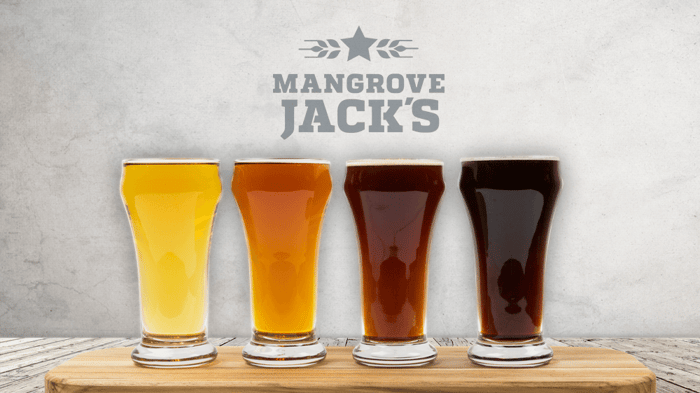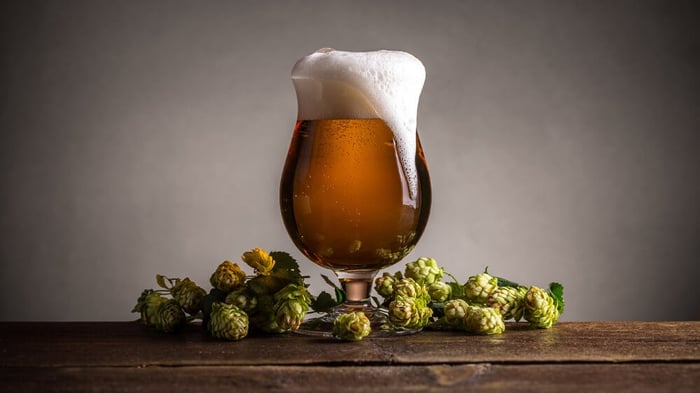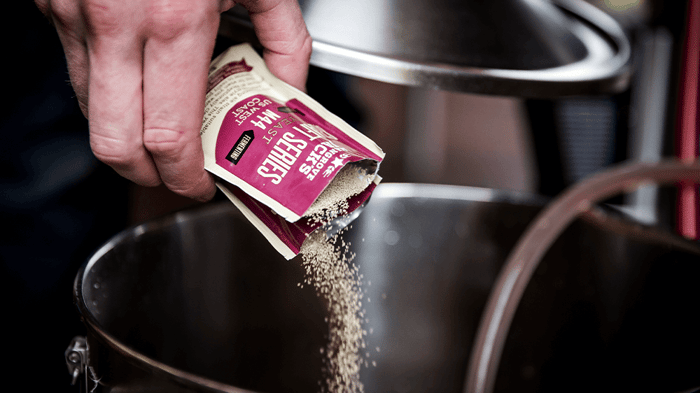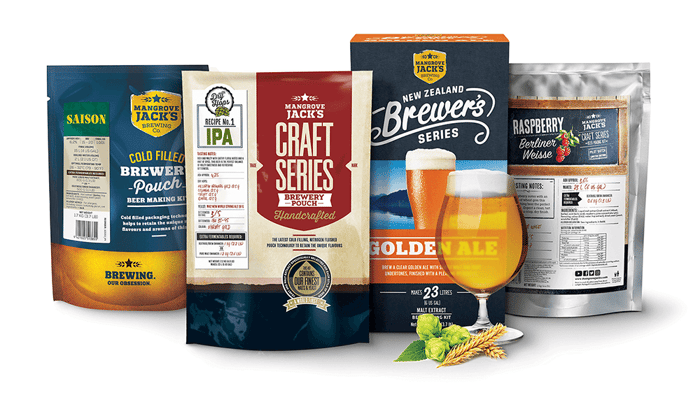As brewers, we strive to always be creating better beer. Drinking it is one thing, but knowing how to taste beer is essential to becoming a better brewer. Below we'll touch on some of the beer tasting basics.
Drinking is easy and unstructured. Tasting however, has rules and a clearly defined purpose.
With good technique, training and practice, you can extract a far greater amount of information from your beer than you might have originally thought - so we decided to put together some basic tips to get you started by learning to "correctly" taste your beer.
We recommend you start developing a habit of taking tasting notes on your brews. This way, you will learn what you like and don’t like about each brew and can make educated changes on your next one. We will be posting more articles on the finer elements of beer tasting in due course, but for those who are completely new to beer tasting, start getting comfortable with the points below...
Temperature Matters!
| Ideal Serving Temperatures by Beer Style | |
| American Macro Lagers/Light Lagers | 0.5°C - 4.4 °C (33°F - 40°F) |
| Pale Lagers/Pilsners | 3.3°C - 5.6 °C (38°F - 42°F) |
| Amber/Marzen/Oktoberfest Lagers | 7.2°C - 10 °C (45°F - 50°F) |
| Blonde Ale/Cream Ale | 4.4°C - 7.2°C (40°F - 45°F) |
| Pale Ale | 7.2°C - 10°C (45°F - 50°F) |
| India Pale Ale | 7.2°C - 12.7°C (45°F - 55°F) |
| Stout/Black Ale/Porter | 7.2°C - 12.7°C (45°F - 55°F) |
| Wheat Beers | 7.2°C - 12.7°C (45°F - 55°F) |
| Sour Beers | 7.2°C - 10°C (45°F - 50°F) |
| Belgian Dubbels/Tripels/Quads | 10°C - 12.7°C (50°F - 55°F) |
Despite common belief, an ice-cold beer isn’t actually giving you the best beer-drinking experience. Chilled is good, but to taste the more complex flavours, the ideal serving temperature is determined by the beer type.
Generally speaking, light lagers are at the low end of the spectrum. Having more delicate flavour profiles, these are best served ice cold as a "thirst-quencher". Fuller-bodied beers like European lagers tend to showcase flavour in a slightly warmer range. Complex beers such as IPAs, Porters and Stouts give their full flavour profile at an even warmer temperature, with
Heavier ales such as Belgian, British and Scottish ales coming in with the warmest recommended serving temperatures.
Using the below recommendations as a guide, take your beer out of the fridge allowing sufficient time for it to get to the right temperature before tasting!
Tip: If your beer is too cold, wrap your fingers around it and give it a swirl - this should (somewhat rapidly) bring the temperature up!
The order matters too...
If you’re tasting more than one type of beer, have a think about which order to do this in before getting started. Start with heavier, hoppy or darker beers and they will take over your palate diminishing your ability to taste the lighter flavours after this.
Use a glass...
While drinking straight from the bottle or can may seem convenient, it’s not the best way to get the full beer aroma and flavour.
When beer is poured into a glass, the agitation of the beer and greater space allows all the complex aromas to swirl up and into your nose. There are specific glasses for different beer types. If you have them, that’s great; if not, a wine glass (or worst case scenario, any old glass) will do just fine!
Note: For bottle-conditioned beers that contain sediment at the bottom, pouring the beer into a glass is particularly important.
Take a good look...
Hold your glass up so it can get some light and check out the colour, clarity, head colour and texture. The colour can range from a light straw colour all the way to black depending on what you’ve been brewing. With clarity it can be clear or hazy/cloudy - entirely dependent on the brew and how it’s brewed/filtered. The colour of the head can be from white to tan or coloured and the texture of the head can be thin and wispy to thick and billowy, are the bubbles big or small? You get the idea - take notes on everything you see!
Well made beer should hold its head with the exception of sour beers. When looking at the glass you should be able to see ‘lacing’ which is foam sticking to the glass as the beer is gently swirled around (much like the legs on wine). If there is no lacing or carbonation in the beer, there is potentially either a problem with the beer or the glass you have used is dirty. At this point it may be worth taking a look at the brewing and cleaning process that you’ve used.
Give it a good smell...
Smelling your brew is the first indication of the flavour it’s going to have. With aroma making up 80% of the whole tasting experience it’s important to take the time to appreciate it. Give your beer another gentle swirl to release more aroma compounds and take short sniffs to get the full effect. Is it intense or smooth? Malty or hoppy? Are you getting fruit notes or more chocolate undertones? Trust your instinct with this one, there is no right or wrong answer!
If you’re having trouble getting the different notes you were expecting try covering the top of the glass with your hand, gently swirl the beer for a few seconds then smell. This will trap the aroma compounds in the mouth of the glass so they’re more concentrated for you to experience.
Now the fun part - taste it!
Finally, sip the beer. Take a big enough sip that you can swish it around in your mouth for a few seconds to get the full flavour and understand the consistency of your brew. What initial flavours are you getting? How does the middle of the flavour compare to the finish?
The three common tastes you’re looking for are
- Sweetness from the malt
- Bitterness from the hops
- Acidity from the brewing process or any added fruit.
As you swallow, close your mouth and breath out through your nose - this will help to give an even fuller flavour. Think about the mouthfeel, is it a thin or thick consistency? Too bubbly or flat? Does it have an astringency (dryness) to it?
Now take a big swig. While you use the first sip to identify the different flavour notes, the swig is where you really get a feel for your brew and understand how palatable it is.
The hardest part of learning to taste is to learn to describe what you are tasting. Have a look at some beer flavour and aroma wheels to develop your vocabulary. To get you up to speed with the beer tasting lingo, below are a few terms that you might use to describe different aspects of your brew.
| Glossary | |
|
Aroma |
Derived from ingredients such as malt and hops but moddified by yeast. |
|
Head |
We assume you know this but just in case, it’s the foam on top of a beer when it’s poured and is caused by carbon dioxide from the proteins in the beer. |
|
Colour |
Mainly from Kilning of your chosen malts, but also affected by mashing, boiling and sometimes fermentation and filtration variables. |
|
Carbonation |
CO2 gas levels - a by-product of fermentation. |
|
Body |
Proteins from malts, influenced by fermentation and filtering. |
|
Mouthfeel |
Sensations relayed by nerves in the mouth that can detect textures, chemical heat and cold, astringency and more. |
|
Flavor |
A synthesis our brain puts together from aroma, taste, mouthfeel, other senses and even our expectations. Much of its complexity comes from aroma, but it is experienced in a different way. |
|
Taste |
Primarily sensations on the tongue. Sweetness, bitterness and acidity are the most important ones in beer. |
|
Finish |
The aftertaste immediately after swallowing. |
|
Descriptive Terms |
|
|
Balanced/Round |
Describes a beer where no one single component overpowers others. |
|
Sessionable |
A beer that you can have many pints of, really this term describes a well balanced beer. |
|
Lightstruck |
When the beer has had too much exposure to light and the hops have become photo-oxidised, also described as a ‘skunky’ vegetal flavour. |
|
Big |
A beer with lots of flavour or alcohol. |
|
Thin |
When the beer lacks body, complexity and flavour. |
|
Chalky |
Describes the mouthfeel when a beer has a powdery or dry finish to it, your mouth feels chalky. |





